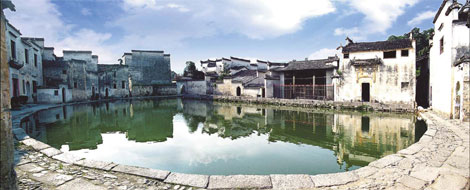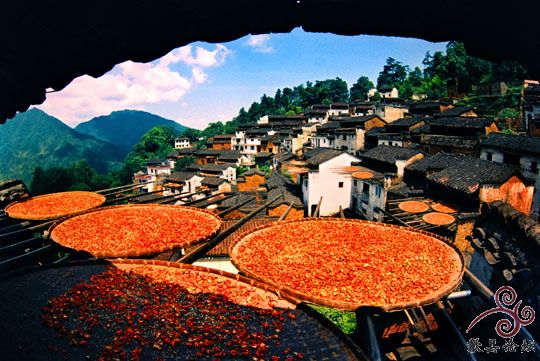本帖最后由 潘冬子 于 2011-7-3 16:42 编辑
Timeless charm  The half-moon shaped pond, named Yuezhao pond, is the center of Hongcun and it is here that village activities revolve, even up to now. Provided to China Daily The half-moon shaped pond, named Yuezhao pond, is the center of Hongcun and it is here that village activities revolve, even up to now. Provided to China Daily |
This is an ancient village untouched by war and chaos, and beautiful in its tranquility. Tan Zongyang visits Hongcun, a village in Anhui that is listed as a UNESCO World Heritage site. Top: White geese swim in the dark green tranquil waters of the village pond. Bottom: Hongcun is the perfect picture of idyllic rural life, seemingly caught in a time warp. Shi Guangde / For China Daily
It was first built in the days of the southern Song dynasty, in 1311. Nine hundred years later, Hongcun is still well preserved, having escaped the turbulence of changing rulers in the Ming and Qing eras and having survived the threats of modernity in more recent years. It was one of the key locations for the filming of Crouching Tiger, Hidden Dragon, Ang Lee's martial arts film that so captured the imagination of Western audiences. In fact, this little village in southern Anhui province, not too far away from the famous Huangshan mountain scenery, resembles an ox on its belly more than the more ferocious beast. The ox itself is an auspicious animal in Chinese beliefs, and Hongcun is laid out according to the principles of fengshui, the Chinese art of geomancy. Its natural position already conforms to the ideal layout, with its back to a mountain, Leigang Hill, and its front facing water, the West Creek. A half-moon pond within the village is the oxen stomach and a larger lake to the south is its belly. The village's winding original man-made irrigation system of stone canals comprises the bovine intestines. Hongcun boasts all the simplicity and calm of ancient rural society, and the 30-hectare village stirs up strong nostalgia for those times, more so even than the more commercialized tourist traps of Lijiang or Pingyao, also World Heritage sites. Looking from the entrance of the village, the vista spreads out and gives the illusion you have stepped into a Chinese ink-and-brush painting. The South Lake, or Nanhu, dug during the Ming Dynasty for irrigation, lies calmly before the village, its mirror-like surface reflecting the contour of distant hills with its row upon row of ancient buildings. The houses and their reflections are in perfect symmetry, even while they are partly veiled by the morning mist. The clustered white-bricked houses and black roofs are typical Anhui-style, and they fit into the "painting" like black silhouettes against a white background. Hongcun has 137 houses on the preservation list, and it is a living museum of traditional Anhui architecture. Like other villages in South Anhui, these village dwellings are tightly packed together, separated by high walls that served both to provide privacy and fire breaks.

The walls may be of differing heights but all are topped with eaves that have corners shaped like horse heads. In ancient days, Anhui men left home to trade when they were as young as 12 or 13, and the horse heads on the walls are good talismans, which ensured that the boys came back home safely, loaded with wealth and honor.
A long stone causeway cuts across South Lake, providing an elegant entry to the village. This was also the location of the curtain raiser in the film Crouching Tiger, Hidden Dragon, when lead actor Chow Yun-fat led his horse across the lake and into the village. In real life, the villagers placed more importance on education than martial arts. On the edge of the lake is the South Lake College, which used to be a family private school, and throughout the village, larger houses had special studies devoted to scholarship.
Almost every lane in the village has a canal murmuring by its edge, part of an ingenious irrigation system devised by the Hongcun elders that ensured fresh water for every household. If you do get lost in the maze of lanes, just follow the water downstream. It flows into the South Lake and will lead you back to the entrance of the village. During the reign of the Emperor Yongle (1403-1424) of the Ming Dynasty, the villagers decided to expand the site, and rearranged the water-supply.
A pond was excavated in the center of the village, the Yuezhao pond, so named because the ancients believed the moon begins to wane the moment it becomes full.

The pond was shaped like a half-moon, so the village will never be on the decline and would remain prosperous forever. It is the scenic center of the village, hugged by pretty folk houses, and its dark green tranquil water looks like inlaid green jade fringed by white geese waddling on the bank. Over time, the pond has become the place where elders gathered to chat, women did their laundry and children played. It was also the heart of village politics, and the clan hall of the Wang family, the founders and leaders of Hongcun, was built beside the pond. In accordance with feng shui principles, two trees were planted to represent the horns of the ox. The 200-year old ginkgo and red aspen trees have witnessed countless marriages, births, and deaths in the village through the ages. There are a number of significant buildings in the village open to the tourists now, such as Chengzhi Hall. Covering an area of more than 2,000 square meters, the mansion was built by a wealthy salt merchant to house his two wives. Apart from general-purpose rooms, the hall also has separate ones for aquariums, reading, mahjong games, and even one for smoking opium. Magnificent wooden beams in the house are gilded, and one reason they survived the sack during the "cultural revolution" was because the residents had smeared and hidden the gold under a layer of mud.
Hongcun not only attracts tourists, but its well-preserved architecture also draw students from art academies all over the country. The village seems timeless, and it is not difficult to imagine that after another 100 years, it will still be here, with its lake, its pond, and its flock of admiring artists trying so hard to capture its soul on paper and canvas.
全文转自2011.7-3《中国日报》外文版 |  |手机版|歙县论坛主站|歙县论坛-歙县老百姓值得信赖的网络平台
( 皖ICP备14023110号-2 |
|手机版|歙县论坛主站|歙县论坛-歙县老百姓值得信赖的网络平台
( 皖ICP备14023110号-2 |![]() 34102102000101 )
34102102000101 )